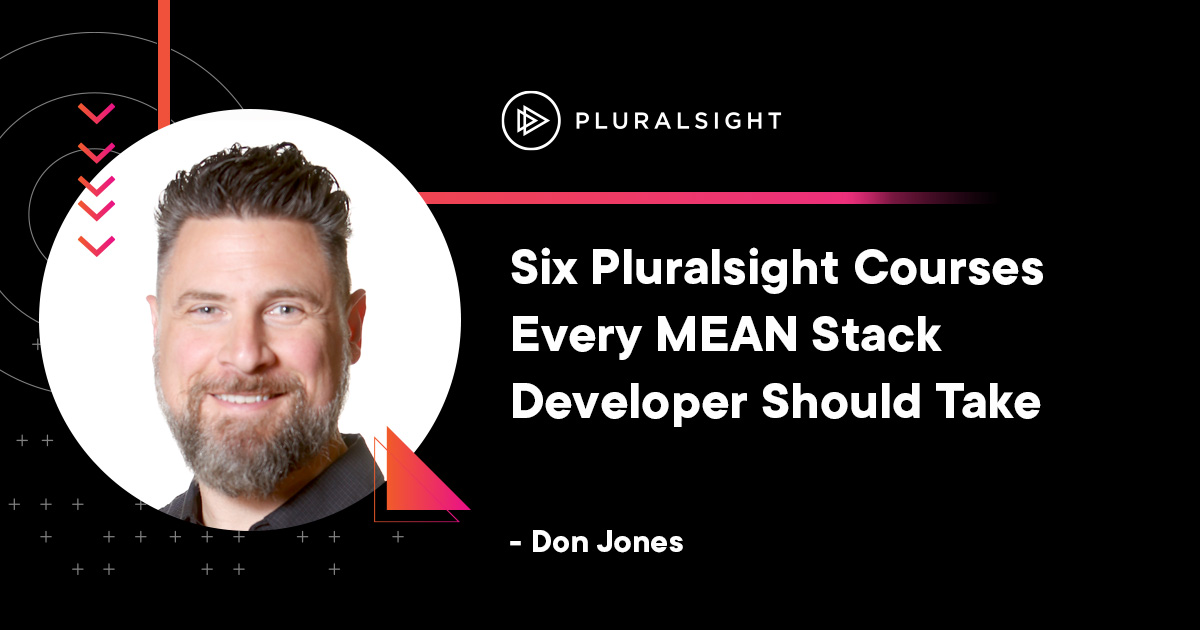Author: Don Jones
Are you a MEAN stack developer or studying to become one? The JavaScript-based framework has grown in popularity for developing cloud-hosted web applications in recent years. Its open-source nature, use of a single programming language, and flexible nature make it attractive to businesses of all sizes in all industries.
This is part three of a four-part series on MEAN Stack.
Whether you’re looking to brush up your skills or are just getting started with MEAN development, you’ll love these six can’t-miss Pluralsight courses. Each one is designed to help you learn to build dynamic web apps and websites.
How to Learn MEAN Stack Development
A quick refresher on MEAN stack development: its name is an acronym. In the first article of this series, we explain what the MEAN stack is and how it works.
Four technologies make up the stack:
M: MongoDB, a NoSQL document database
E: Express (.js), a Node.js framework
A: Angular (.js), a structural JavaScript framework
N: Node(.js), a JavaScript web server
MEAN stack developers leverage the four layers to develop web apps and websites by working on both front and back-end systems.
If you’re ready to learn MEAN stack development, this 6-step path will help get you there.
1. Using MongoDB with Node.js
We recommend starting with the “M” layer or MongoDB database. MongoDB databases house data in JSON-like documents. This first layer sets up the MEAN stack with plenty of accessibility, as you can easily pass data from the client to the server.
The first MEAN stack course in our playlist is Using MongoDB with Node.js. This beginner-level course will walk you through how to access, manipulate, and aggregate data stored in a MongoDB database. In just over an hour, you’ll discover how to:
- create and interact with a MongoDB database
- implement Create, Read, Update, and Delete (CRUD) using a repository object
- use Aggregation pipeline built into MongoDB
- build MongoDB into Node.js applications
2. Introduction to MongoDB
We haven’t quite left the M layer just yet. Next up on our list of essential MEAN Stack tutorials, we have an Introduction to MongoDB. This course bumps things up to the intermediate level. After completing the two-and-a-half-hour course, you can expect to walk away with the knowledge needed to make the most of the popular NoSQL database.
For best results, make sure you have some experience with databases, Java programming, and Big Data platforms. You can get up to speed with our MySQL paths and Java courses.
3. Building Web Applications with Node.js and Express
Moving right along into the “E” layer, it’s time to get to know Express.js. Jump right into the essentials of this lightweight framework in Building Web Applications with Node.js and Express. This course will guide you through building Express 4.0 applications with Node.js. The intermediate-level tutorial runs at about three hours, jam packed with insights and best practices.
4. Code with Us: Angular Quick Start
Up next on our MEAN.js tutorial playlist, we have our first “A” course: Code with Us: Angular Quick Start. Jumpstart your Angular experience with experts John Papa and Ward Bell. You’ll get a closer look at what writing an application in Angular is like as the two development pros build a customer management application from scratch.
You won’t just be observing, however. You’ll also complete exercises so you can learn how to:
- display data by creating visual components
- use data binding to respond to user input
- write services to retrieve the data over HTTP
- organize code in modules
- test your code
5. Angular: Getting Started
The Angular: Getting Started course is ideal for beginners who want to dig deeper into the JavaScript framework. Led by Microsoft Most Valuable Professional Deborah Kurata, the class will teach you to master one of the hottest open-source web app frameworks.
If you aren’t familiar with JavaScript, HTML, CSS, and object-oriented programming, you’ll want to study that material before pressing play on this class.
Clocking in at nearly six hours, Angular: Getting Started drills down into major topics such as:
- setting up your environment
- components, templates, and data binding
- building clean and nested components
- using dependency injection to inject the services you build
- retrieve data using HTTP, navigation, and routing
If you’re looking to leave the course with the knowledge to use Angular for web app development, you’re right on track. You can even expand your knowledge by diving into additional Angular Learning Path courses.
6. Node.js: Getting Started
Node.js may make up the final layer of the MEAN Stack, but that doesn’t mean it isn’t absolutely essential to the framework. Node.js serves as the back-end of the tech stack. If the phrase “back-end services” makes you think of long hours and lots of frustration, don’t stress. In Node.js: Getting Started, you’ll learn how to save time and increase efficiency with the JavaScript web server.
Join polyglot coder Samer Buna as he explains how to create and execute code for Node.js. The beginner-level course breaks down the skills required to create scalable back-end services, modern JavaScript concepts, common tools, package management, module dependencies, and more.
Wondering what it’s like to be a MEAN stack developer? Stay tuned to the final article in our four-part series, where we follow along with a MEAN stack developer for a day.
Our MEAN stack developer series:
- Part One: MEAN Stack Development 101
- Part Two: Full vs. MEAN stack developer: Which career is right for you?
